Vitaly Lavrukhin
Training and Inference Efficiency of Encoder-Decoder Speech Models
Mar 07, 2025Abstract:Attention encoder-decoder model architecture is the backbone of several recent top performing foundation speech models: Whisper, Seamless, OWSM, and Canary-1B. However, the reported data and compute requirements for their training are prohibitive for many in the research community. In this work, we focus on the efficiency angle and ask the questions of whether we are training these speech models efficiently, and what can we do to improve? We argue that a major, if not the most severe, detrimental factor for training efficiency is related to the sampling strategy of sequential data. We show that negligence in mini-batch sampling leads to more than 50% computation being spent on padding. To that end, we study, profile, and optimize Canary-1B training to show gradual improvement in GPU utilization leading up to 5x increase in average batch sizes versus its original training settings. This in turn allows us to train an equivalent model using 4x less GPUs in the same wall time, or leverage the original resources and train it in 2x shorter wall time. Finally, we observe that the major inference bottleneck lies in the autoregressive decoder steps. We find that adjusting the model architecture to transfer model parameters from the decoder to the encoder results in a 3x inference speedup as measured by inverse real-time factor (RTFx) while preserving the accuracy and compute requirements for convergence. The training code and models will be available as open-source.
TTS-Transducer: End-to-End Speech Synthesis with Neural Transducer
Jan 10, 2025Abstract:This work introduces TTS-Transducer - a novel architecture for text-to-speech, leveraging the strengths of audio codec models and neural transducers. Transducers, renowned for their superior quality and robustness in speech recognition, are employed to learn monotonic alignments and allow for avoiding using explicit duration predictors. Neural audio codecs efficiently compress audio into discrete codes, revealing the possibility of applying text modeling approaches to speech generation. However, the complexity of predicting multiple tokens per frame from several codebooks, as necessitated by audio codec models with residual quantizers, poses a significant challenge. The proposed system first uses a transducer architecture to learn monotonic alignments between tokenized text and speech codec tokens for the first codebook. Next, a non-autoregressive Transformer predicts the remaining codes using the alignment extracted from transducer loss. The proposed system is trained end-to-end. We show that TTS-Transducer is a competitive and robust alternative to contemporary TTS systems.
Anticipating Future with Large Language Model for Simultaneous Machine Translation
Oct 29, 2024



Abstract:Simultaneous machine translation (SMT) takes streaming input utterances and incrementally produces target text. Existing SMT methods only use the partial utterance that has already arrived at the input and the generated hypothesis. Motivated by human interpreters' technique to forecast future words before hearing them, we propose $\textbf{T}$ranslation by $\textbf{A}$nticipating $\textbf{F}$uture (TAF), a method to improve translation quality while retraining low latency. Its core idea is to use a large language model (LLM) to predict future source words and opportunistically translate without introducing too much risk. We evaluate our TAF and multiple baselines of SMT on four language directions. Experiments show that TAF achieves the best translation quality-latency trade-off and outperforms the baselines by up to 5 BLEU points at the same latency (three words).
Chain-of-Thought Prompting for Speech Translation
Sep 17, 2024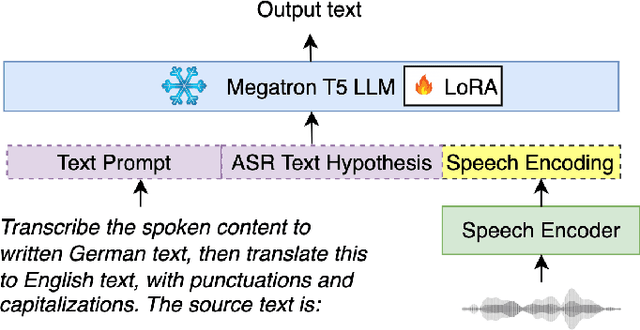
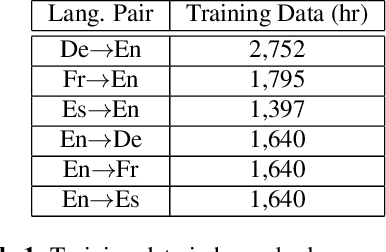
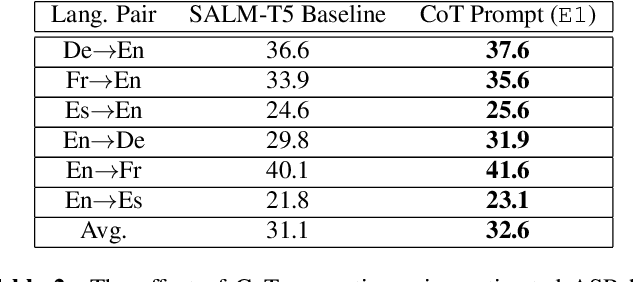
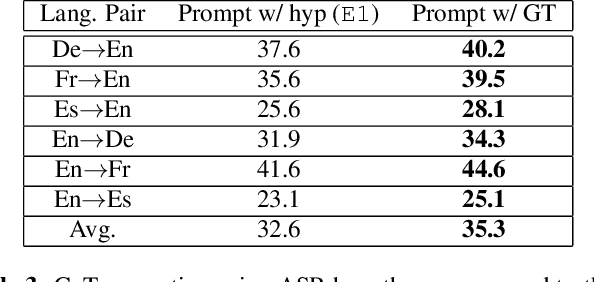
Abstract:Large language models (LLMs) have demonstrated remarkable advancements in language understanding and generation. Building on the success of text-based LLMs, recent research has adapted these models to use speech embeddings for prompting, resulting in Speech-LLM models that exhibit strong performance in automatic speech recognition (ASR) and automatic speech translation (AST). In this work, we propose a novel approach to leverage ASR transcripts as prompts for AST in a Speech-LLM built on an encoder-decoder text LLM. The Speech-LLM model consists of a speech encoder and an encoder-decoder structure Megatron-T5. By first decoding speech to generate ASR transcripts and subsequently using these transcripts along with encoded speech for prompting, we guide the speech translation in a two-step process like chain-of-thought (CoT) prompting. Low-rank adaptation (LoRA) is used for the T5 LLM for model adaptation and shows superior performance to full model fine-tuning. Experimental results show that the proposed CoT prompting significantly improves AST performance, achieving an average increase of 2.4 BLEU points across 6 En->X or X->En AST tasks compared to speech prompting alone. Additionally, compared to a related CoT prediction method that predicts a concatenated sequence of ASR and AST transcripts, our method performs better by an average of 2 BLEU points.
Less is More: Accurate Speech Recognition & Translation without Web-Scale Data
Jun 28, 2024Abstract:Recent advances in speech recognition and translation rely on hundreds of thousands of hours of Internet speech data. We argue that state-of-the art accuracy can be reached without relying on web-scale data. Canary - multilingual ASR and speech translation model, outperforms current state-of-the-art models - Whisper, OWSM, and Seamless-M4T on English, French, Spanish, and German languages, while being trained on an order of magnitude less data than these models. Three key factors enables such data-efficient model: (1) a FastConformer-based attention encoder-decoder architecture (2) training on synthetic data generated with machine translation and (3) advanced training techniques: data-balancing, dynamic data blending, dynamic bucketing and noise-robust fine-tuning. The model, weights, and training code will be open-sourced.
Fast Context-Biasing for CTC and Transducer ASR models with CTC-based Word Spotter
Jun 11, 2024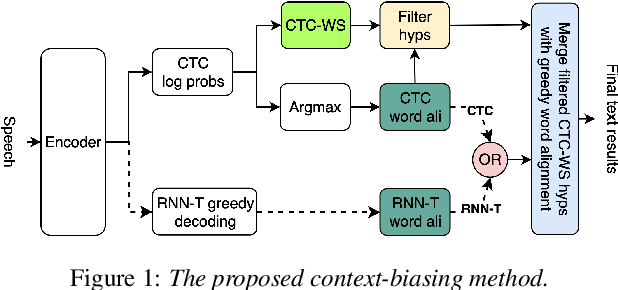
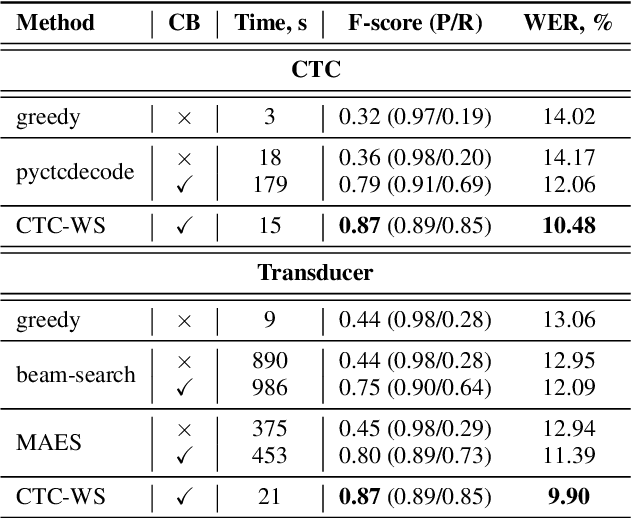
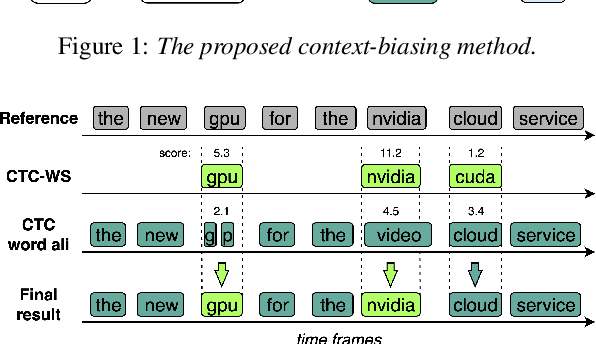
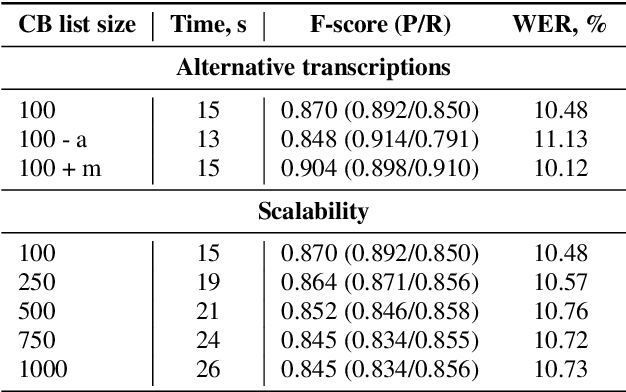
Abstract:Accurate recognition of rare and new words remains a pressing problem for contextualized Automatic Speech Recognition (ASR) systems. Most context-biasing methods involve modification of the ASR model or the beam-search decoding algorithm, complicating model reuse and slowing down inference. This work presents a new approach to fast context-biasing with CTC-based Word Spotter (CTC-WS) for CTC and Transducer (RNN-T) ASR models. The proposed method matches CTC log-probabilities against a compact context graph to detect potential context-biasing candidates. The valid candidates then replace their greedy recognition counterparts in corresponding frame intervals. A Hybrid Transducer-CTC model enables the CTC-WS application for the Transducer model. The results demonstrate a significant acceleration of the context-biasing recognition with a simultaneous improvement in F-score and WER compared to baseline methods. The proposed method is publicly available in the NVIDIA NeMo toolkit.
Label-Looping: Highly Efficient Decoding for Transducers
Jun 10, 2024



Abstract:This paper introduces a highly efficient greedy decoding algorithm for Transducer inference. We propose a novel data structure using CUDA tensors to represent partial hypotheses in a batch that supports parallelized hypothesis manipulations. During decoding, our algorithm maximizes GPU parallelism by adopting a nested-loop design, where the inner loop consumes all blank predictions, while non-blank predictions are handled in the outer loop. Our algorithm is general-purpose and can work with both conventional Transducers and Token-and-Duration Transducers. Experiments show that the label-looping algorithm can bring a speedup up to 2.0X compared to conventional batched decoding algorithms when using batch size 32, and can be combined with other compiler or GPU call-related techniques to bring more speedup. We will open-source our implementation to benefit the research community.
LibriSpeech-PC: Benchmark for Evaluation of Punctuation and Capitalization Capabilities of end-to-end ASR Models
Oct 04, 2023Abstract:Traditional automatic speech recognition (ASR) models output lower-cased words without punctuation marks, which reduces readability and necessitates a subsequent text processing model to convert ASR transcripts into a proper format. Simultaneously, the development of end-to-end ASR models capable of predicting punctuation and capitalization presents several challenges, primarily due to limited data availability and shortcomings in the existing evaluation methods, such as inadequate assessment of punctuation prediction. In this paper, we introduce a LibriSpeech-PC benchmark designed to assess the punctuation and capitalization prediction capabilities of end-to-end ASR models. The benchmark includes a LibriSpeech-PC dataset with restored punctuation and capitalization, a novel evaluation metric called Punctuation Error Rate (PER) that focuses on punctuation marks, and initial baseline models. All code, data, and models are publicly available.
A Chat About Boring Problems: Studying GPT-based text normalization
Sep 23, 2023Abstract:Text normalization - the conversion of text from written to spoken form - is traditionally assumed to be an ill-formed task for language models. In this work, we argue otherwise. We empirically show the capacity of Large-Language Models (LLM) for text normalization in few-shot scenarios. Combining self-consistency reasoning with linguistic-informed prompt engineering, we find LLM based text normalization to achieve error rates around 40\% lower than top normalization systems. Further, upon error analysis, we note key limitations in the conventional design of text normalization tasks. We create a new taxonomy of text normalization errors and apply it to results from GPT-3.5-Turbo and GPT-4.0. Through this new framework, we can identify strengths and weaknesses of GPT-based TN, opening opportunities for future work.
Conformer-based Target-Speaker Automatic Speech Recognition for Single-Channel Audio
Aug 09, 2023



Abstract:We propose CONF-TSASR, a non-autoregressive end-to-end time-frequency domain architecture for single-channel target-speaker automatic speech recognition (TS-ASR). The model consists of a TitaNet based speaker embedding module, a Conformer based masking as well as ASR modules. These modules are jointly optimized to transcribe a target-speaker, while ignoring speech from other speakers. For training we use Connectionist Temporal Classification (CTC) loss and introduce a scale-invariant spectrogram reconstruction loss to encourage the model better separate the target-speaker's spectrogram from mixture. We obtain state-of-the-art target-speaker word error rate (TS-WER) on WSJ0-2mix-extr (4.2%). Further, we report for the first time TS-WER on WSJ0-3mix-extr (12.4%), LibriSpeech2Mix (4.2%) and LibriSpeech3Mix (7.6%) datasets, establishing new benchmarks for TS-ASR. The proposed model will be open-sourced through NVIDIA NeMo toolkit.
 Add to Chrome
Add to Chrome Add to Firefox
Add to Firefox Add to Edge
Add to Edge